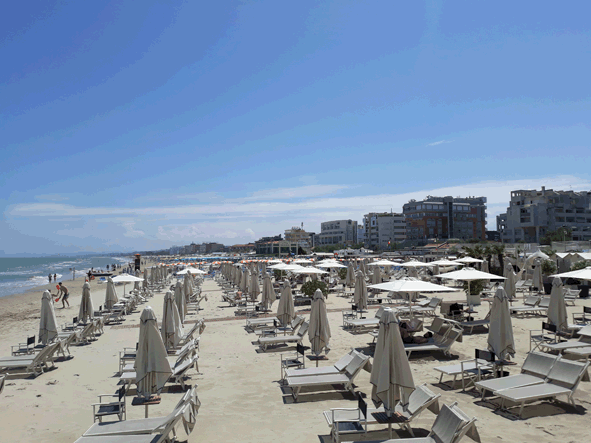Regenerating with the green: a proposal for the coastal landscape of Senigallia
DOI:
https://doi.org/10.6092/2281-4574/5820Keywords:
Coastal landscape, green infrastructures, urban regenerationAbstract
Urban regeneration of a coastal territory should consider the local coastal landscape as a key element for boosting local sustainable growth. Starting from this assumption the regeneration proposal for the coastal belt of Senigallia (Italy) puts a strong emphasis on landscape, which allows to understand the complexity of the coastline’s natural and anthropic system in a holistic way.Senigallia owes its touristic attractiveness to the beach, which is the main touristic reference for local, national and international tourism and the most important meeting place for summer activities and events. At the same time, it shows critical issues such as the limited extension in relation with the touristic arrivals, paths fragmentation along the coast and episodes of urban decay. Tourism generates high pressures not only on the beach portions with high concentration of resorts and facilities, but also on those parts that are still predominately wild and less anthropized, undermining the distinctive elements of local landscape.
In this framework, natural areas valorisation and urban quality improvement are assumed as main objectives of the regeneration of the entire Senigallia’s coastal strip. The proposal is based on strengthening the green infrastructure along the coast, allowing to improve the quality of the natural and the urban environments by giving continuity to the existing paths along the coast and by connecting the urbanized areas with the local natural systems.
Downloads
References
Antrop M. ( 2005), “Why landscapes of the past are important for the future”, Landscape and Urban Planning, 70, Issues 1–2, 15 January 2005, Elsevier, pp. 21-34
Bobbio R., Lombardini G. (2017), “Bellezza ed economia dei paesaggi costieri. Esiti e prospettive di un progetto di ricerca”, Ri-Vista Ricerche per la progettazione del paesaggio, 02, Firenze University press, Firenze, pp. 120-135. [Online: www.unifi.it/ri-vista, accessed on July 2018]
Clément G. (2005), Manifesto del Terzo Paesaggio, Quodlibet, Macerata
Clementi A., a cura di (2002), Interpretazioni di paesaggio, Meltemi, Roma
Collina S., (2015), “Strumenti di pianificazione del verde urbano in Italia. Studio sulle principali cittá italiane”, Tesi di Stage, ISPRA
Conticelli E., Minelli A., Pasini I., Tondelli S. (2010), “La valorizzazione del paesaggio rurale nel piano strutturale del verde del comune di Senigallia”, PAYSAGE, vol. 5, pp. 1 – 7
Cosgrove D. (1985), “Prospect, Perspective and the Evolution of the Landscape Idea”, Transactions of the Institute of British Geographers, New Series, Vol. 10, No. 1, Wiley-Blackwell, Hoboken, pp. 45-62
Council of Europe (2000), European Landscape Convention, European Treaty Series - No. 176, Florence, 20.X.2000
Gregotti V. (1966), Il territorio dell’architettura, Feltrinelli, Milano
Hadley D., (2009), “Land use and the coastal zone”, Land Use Policy, 26S (2009), Elsevier, New York, pp. 198-203
Ignatieva M., Stewart G. H., Meurk C. (2011), Planning and design of ecological networks in urban areas, Landscape Ecol Eng, 7, Springer, pp. 17–25
Maruani T., Amit-Cohen I., (2007), “Open space planning models: A review of approaches and methods”, Landscape and Urban Planning, 81, Elsevier, New York, pp 1–13
Olwig K. R. (1996), “Recovering the Substantive Nature of Landscape”, Annals of the Association of American Geographers, Vol. 86, No. 4, Taylor & Francis, Ltd., Abingdon, pp.630-653
Peano, A., Voghera, A. (2010), “Conoscenza, valutazione, monitoraggio del paesaggio”, Agribusiness Paesaggio & Ambiente, Vol XIII:n. 3, Marzo 2010, Forum Editrice Universitaria Udinese, Udine, pp. 190-197.
Saiani M. (2011), “Waterfront requalification of the City of Senigallia”, Master’s degree thesis in Urban Planning, University of Bologna
Searns R. M., (1995), The evolution of greenways as an adaptive urban landscape form, Landscape and Urban Planning, 33, Elsevier, New York, pp 65-80
Vallega A., (2003), The Coastal Cultural Heritage Facing Coastal Management, Journal of Cultural Heritage, Elsevier, New York, IV (1), pp. 5-24
Voghera A., La Riccia L. (2016), “La Convenzione Europea del Paesaggio alla prova dell’operatività locale. Sperimentalismi disciplinari e problemi aperti”, Ri-Vista Ricerche per la progettazione del paesaggio, 01, Firenze University press, Firenze, pp. 10-23. [Online: www.unifi.it/ri-vista, accessed on July 2018]
Zoppi M. (2003), “Paesaggio: evoluzione di un concetto”, Ri-Vista Ricerche per la progettazione del paesaggio, anno 1,0, gen-set 2003, Firenze University press, Firenze, pp. 1-4. [Online: www.unifi.it/ri-vista, accessed on April 2018]

Downloads
Published
Issue
Section
License
Gli autori che pubblicano su questa rivista accettano le seguenti condizioni:- Gli autori mantengono i diritti sulla loro opera e cedono alla rivista il diritto di prima pubblicazione dell'opera, contemporaneamente licenziata sotto una Licenza Creative Commons - Attribuzione che permette ad altri di condividere l'opera indicando la paternità intellettuale e la prima pubblicazione su questa rivista.
- Gli autori possono aderire ad altri accordi di licenza non esclusiva per la distribuzione della versione dell'opera pubblicata (es. depositarla in un archivio istituzionale o pubblicarla in una monografia), a patto di indicare che la prima pubblicazione è avvenuta su questa rivista.
- Gli autori possono diffondere la loro opera online (es. in repository istituzionali o nel loro sito web) prima e durante il processo di submission, poiché può portare a scambi produttivi e aumentare le citazioni dell'opera pubblicata (Vedi The Effect of Open Access).

